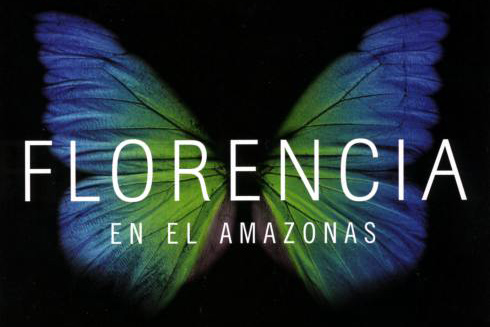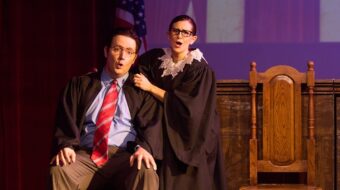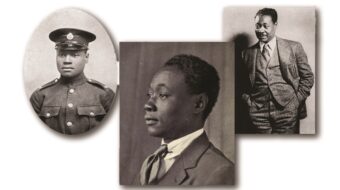
LOS ANGELES – Who says the operatic art form is dead? Simply put, Florencia en el Amazonas is among the finest operas this reviewer has ever seen. In terms of stagecraft and theatrical special effects, composer Daniel Catán’s Amazonas is superb, even exceeding the Broadway production of Phantom (which is, of course, set largely in an opera house) in onstage visual wizardry. Regarding plot, it is more like Joseph Conrad’s 1899 novella Heart of Darkness, with its tale of ivory traders embarking on an odyssey into the jungle.
But instead of floating down the Congo River on a steamboat into “deepest, darkest” Central Africa, the opera’s El Dorado (as the paddle wheeler is symbolically named) traverses the Amazon River, from Leticia (Colombia) to Manaus, Brazil, the Amazon’s largest city and a major port for ocean vessels, although it’s about 1000 miles from the Atlantic. However, Amazonas thematically departs from Conrad’s meditation on imperialism and reversion to savagery: This 1997 work, with a libretto by Marcela Fuentes-Berain, is about that elusive quest not for ivory but for “a crazy little thing called love,” as Freddie Mercury so eloquently put it.
The passengers aboard this ship of fools for love are inspired by the late Colombian literary lion, and winner of the Nobel Prize in Literature, Gabriel García Márquez, although this work is not an operatic adaptation of any of his novels per se. The dramatis personae include: The title character, Florencia Grimaldi (Chilean soprano Verónica Villarroel), a renowned diva traveling incognito en route to reopen Manaus’ opera house and seeking her long lost love Cristóbal, a butterfly hunter. Paula (mezzo soprano Nancy Fabiola Herrera from Spain’s Canary Islands who, appropriately enough, sings like, well, a canary) and Alvaro (American baritone Gordon Hawkins) are a middle-aged couple who hope the flame of their passion will be relit by hearing Florencia’s stirring arias. The lovely, youthful Rosalba (New Orleans soprano Lisette Oropesa) is a would-be writer.
Onboard the El Dorado, Rosalba encounters the young sailor Arcadio (Sonora tenor Arturo Chacón-Cruz), who expresses ennui regarding his job to his uncle, the straight-arrow Captain (American bass-baritone David Pittsinger). Crewmates can be colorful characters, and in Act I Australian baritone José Carbó perfectly captures this piquant quality as Ríolobo. Unfortunately, in the second act this character – whom Performances Magazine calls the “spirit of the river” – all but floats away offstage.
Amazonas‘ real “star” is the El Dorado – kudos to scenery designer Robert Israel and director Francesca Zambello, whose recent evocation of a man o’ war at the Dorothy Chandler Pavilion in last season’s Melvillean Billy Budd also featured a maritime theme. The trials and tribulations that befall the El Dorado during its river journey are spectacular to watch onstage. Lighting designer Mark McCullough does yeoman’s work to assist Israel in rendering these FX, along with spellbinding projections.
At times the paddle wheeler actually moves onstage, starboard to portside and back. As for going full steam ahead, the charming images rendered on scrims and backdrops by projections designer S. Katy Tucker provide the illusion of frontal movement down the river. The projections of the Amazon’s flora and fauna are lovely to behold in this enchanting production, enhancing its magical realist vibe, with imagery that has an Henri Rousseau dreamlike quality.
(Fun Fact of the Day: Despite his many jungly canvases, Rousseau never set foot in or his eyes on a jungle in his entire life.)
Catán’s LA Opera-commissioned Il Postino – which had its world premiere at the Dorothy Chandler in 2010, with none other than Il Maestro, Plácido Domingo himself, portraying Chilean Communist poet Pablo Neruda, and Ms. Herrera as Doña Rosa – also made superb use of scrims and onstage special effects to literally visualize poetry and poesy, the act of creating poetry.
A quintet of dancers, who may be Amazonian indigenous people or water sprites, performing balletic movements choreographed by Eric Sean Fogel, add to the opera’s mysterious, exotic ambiance.
Like librettist Fuentes-Berain (who is also an acclaimed screenwriter mentored by Gabriel García Márquez), Catán hailed from Mexico City, which explains why their opera is sung in Spanish (rather than Portuguese, Brazil’s national language). Overhead English supertitles translate the libretto. This was the first opera in the Spanish language commissioned by a major North American opera company. Catán, who taught music at Santa Clarita’s College of the Canyons near Los Angeles, helped to bring the operatic medium into the 21st century and to enthusiastically infuse it with new blood, utilizing not only up-to-date technology for his theatrical purposes, but an enlarged orchestral palette reflecting the sound atmosphere of tropical America. His opera version of Frank Capra’s 1941 populist picture Meet John Doe was left uncompleted owing to Catán’s untimely death in 2011.
Fuentas-Berain’s lyrics, Catán’s music, ably conducted by Grant Gershon, combined with soaring performances expressing the meaning of romance, plus eye-popping sets and special effects that are sometimes aerial (keep your eyes peeled!) as well as nautical, combine and conspire to make Florencia en el Amazonas a voyage of the blessed. El Dorado’s gold, but of course, is true love. So take someone you love to see a tour de force down the Amazon that never loses its head of steam.
Florencia en el Amazonas is performed on Sundays, Nov. 30 and Dec. 14 at 2:00 pm and Dec. 10, 18 and 20 at 7:30 pm at LA Opera at the Dorothy Chandler Pavilion, 135 N. Grand Ave. For more info: (213) 972-8001; www.laopera.com.












Comments